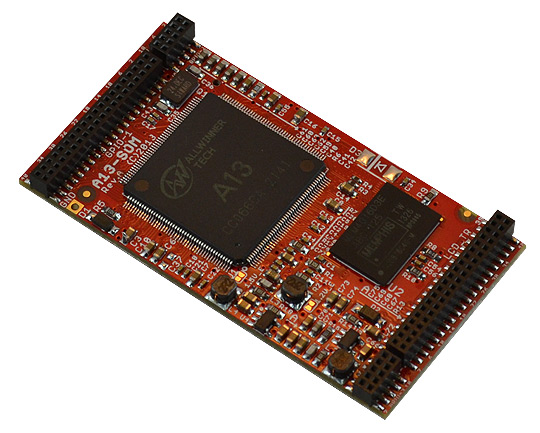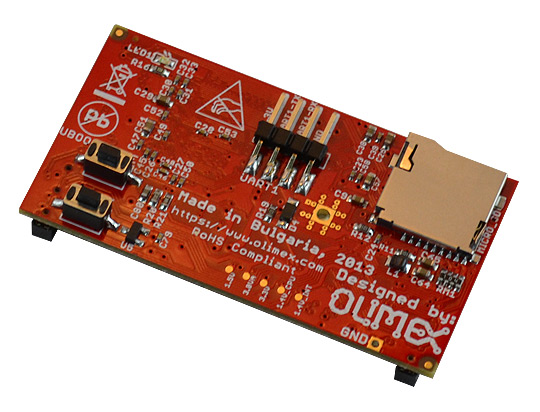A13-SOM
A13-SOM-XXX features:
- A13 Cortex-A8 CPU and Mali 400 GPU
- 256 or 512MB DDR3 RAM memory
- Power supply managment
- 1x LCD connector
- 3x GPIO connectors
- MicroSD card connector
- DEBUG-UART connector for console debug with USB-SERIAL-CABLE-F
- status LED
- Power LED
- RESET button
- 3.3V input power supply
- PCB dimensions: 61 x 33 mm
Official Images from OLIMEX
Linux
[ A13-SOM-256 Debian 4GB SD-card image release-1 with hardware accelerated video and:] [ A13-SOM-512 Debian 4GB SD-card image release-1 with hardware accelerated video and:]
- Linux Kernel 3.4.90+
- XFCE4 desktop environment
- Mplayer CLI
- GCC 4.6
- 4.3"(480x272), 7"(800x480), 10" (1024x600) and 15.6" (1366x768) LCD and touchscreen support
- GPIO
- I2C
- USB WIFI RTL8188CU, Ethernet AX88772B
- dpkg
- git
- i2c-tools
- perl
- xorg
- Python 2.7
- USB-ETHERNET-AX88772B
- MOD-WIFI-RTL8188
- A13-LCD 4.3″TS 4.3″ LCD with backlight and touchscreen 480×272 pixels
- A13-LCD7″TS 7″ LCD with backlight and touchscreen 800×480 pixels
- A10-LCD10″TS 10.1″ LCD with backlight and touchscreen 1024×600 pixels
- Micro SD card
- OTG USB
- HIGH SPEED HOST1 USB
- I2C2(100KHz)
- I2C1(100KHz)
- Default Login: root/olimex
Tested board peripherals with this image:
- GPIO - located at /sys/class/gpio
- LCD - supported are A13-LCD4.3TS, A13-LCD7TS, A13-LCD10TS
- Touch screen - you need calibrate LCD before using touch screen. Type: ts_calibrate and then test it with ts_test
- ASIX 8877 USB-LAN - USB-ETHERNET-AX88772B
- RTL8188CU - MOD-WIFI-RTL8188
- USB_OTG - works as OTG device and Low/Full/High USB host
- USB_HOST - works as Low/Full/High USB host
- mico_SD_card - allow Linux boot
- I2C2(100KHz) - /dev/i2c-2
- I2C1(100KHz) - /dev/i2c-1
Note: the A13-SOM-Debian-SD card which we have in our web store contains the same image on 4GB Class10 fast micro SDcard, if you want to use this image please use card of Class10 speed or the performance of Linux will be very slow.
Note: in the previous Debian releases the Ethernet was auto-detected and initialized during boot BUT this was causing big delays in the start-up of the board if you didn't want to use Ethernet or if there wasn't Ethernet cable connected.
You can enable it by following these two steps:
1. To check under what name the LAN is associated write "ifconfig –a"
2. If, for example, it is under eth0 name, then write: "dhclient eth0"
This should enable the Ethernet and then SSH would also be available.




